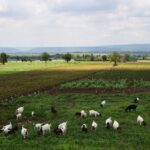Crop rotation is a time-tested agricultural practice that can significantly enhance soil health, improve yields, and reduce pest and disease pressure. In South Africa, where diverse climates and soil types prevail, effective crop rotation can be particularly beneficial. Here are ten ways to utilize crop rotation effectively in South Africa:
- Diversify Crop Types: Rotate between a variety of crops, including grains, legumes, and root vegetables. This diversity helps prevent soil nutrient depletion and reduces the risk of pest and disease buildup specific to one crop type.
- Incorporate Legumes: Include leguminous crops like beans, peas, or soybeans in your rotation. Legumes fix atmospheric nitrogen into the soil, improving soil fertility and reducing the need for synthetic fertilizers.
- Alternate Deep and Shallow Rooted Crops: Rotate between crops with different root depths. Deep-rooted plants, such as maize, can break up compacted soil, while shallow-rooted crops, like lettuce, can improve surface soil structure.
- Use Cover Crops: Plant cover crops during the off-season to prevent soil erosion, enhance organic matter, and improve soil structure. Cover crops like clover or rye can also help manage soil fertility and suppress weeds.
- Implement a Three-Year Cycle: A common rotation system involves growing crops from different families each year. For example, follow a cycle of legumes, cereals, and root vegetables over three years to maintain soil health and fertility.
- Match Crops to Soil Type: Tailor your crop rotation plan to the specific soil types on your farm. For instance, root vegetables may benefit from sandy soils, while legumes thrive in well-drained loamy soils.
- Manage Soil pH: Rotate crops to manage soil pH levels effectively. Certain crops, like brassicas, can acidify the soil, while others, such as legumes, may help neutralize acidity.
- Address Pest and Disease Pressure: Rotate crops to break the life cycles of pests and diseases. For example, if a soil-borne disease affects potatoes, follow with a crop that is not susceptible to that pathogen to reduce disease recurrence.
- Adapt to Climate Variability: South Africa’s diverse climate zones require tailored crop rotation strategies. In regions with variable rainfall, consider rotations that include drought-resistant crops to manage water availability and reduce risk.
- Plan for Market Demand: Align your crop rotation plan with market demands and prices. Rotating crops based on current market trends can optimize profitability and ensure you’re growing crops that are in demand.
Effective crop rotation not only enhances soil health and productivity but also contributes to sustainable farming practices. By following these strategies, South African farmers can optimize their crop rotation plans to achieve better yields, healthier soils, and improved resilience to pests and diseases.
Join 'Farmers Mag' WhatsApp Channel
Get the latest Farming news and tips delivered straight to your WhatsApp
CLICK HERE TO JOIN






